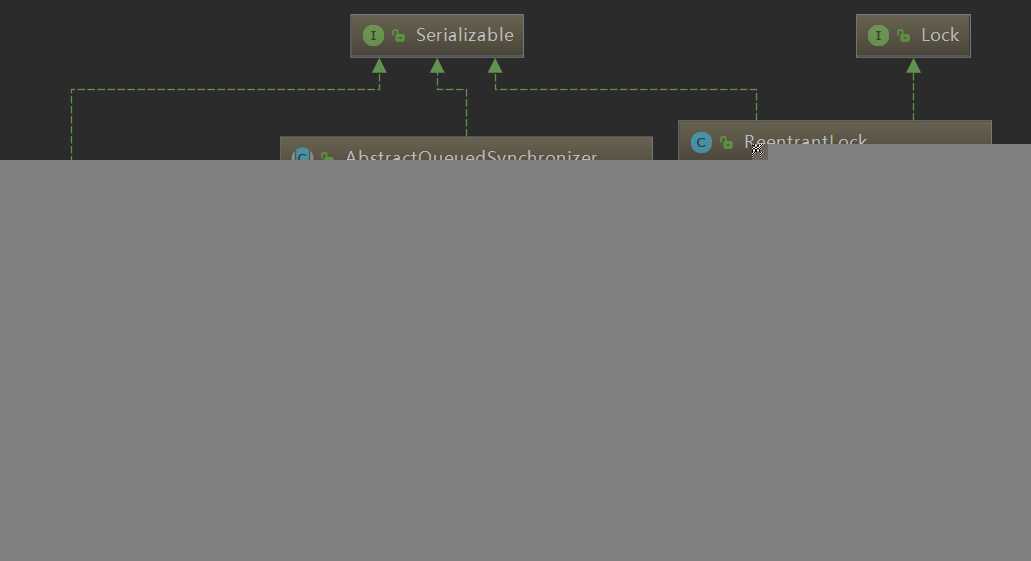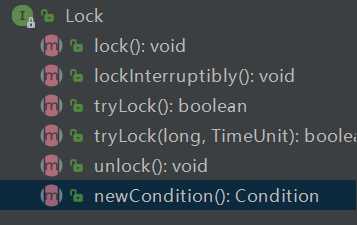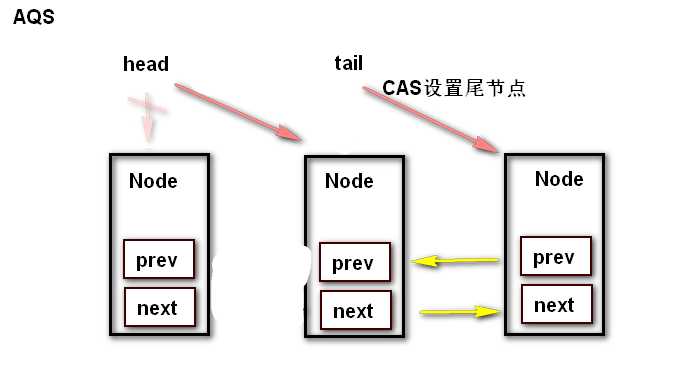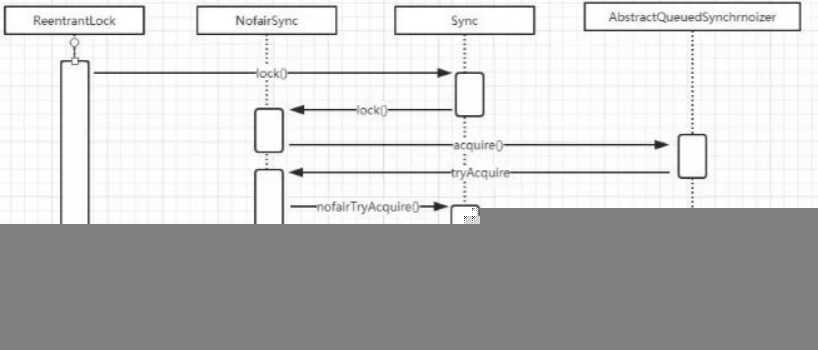标签:order 安全性 通知 use play 做什么 readwrite wait RKE
Lock 有很多的锁的实现,但是直观的实现是 ReentrantLock 重入锁
 |
 void lock() // 如果锁可用就获得锁,如果锁不可用就阻塞直到锁释放
void lockInterruptibly() // 和lock()方法相似, 但阻塞的线程 可 中 断 , 抛 出java.lang.InterruptedException 异常
boolean tryLock() // 非阻塞获取锁;尝试获取锁,如果成功返回 true
boolean tryLock(longtimeout, TimeUnit timeUnit)//带有超时时间的获
取锁方法
void unlock() // 释放锁
|
public class ReentrantDemo{ public synchronized void demo(){ System.out.println("begin:demo"); demo2(); } public void demo2(){ System.out.println("begin:demo1"); synchronized (this){ } } public static void main(String[] args) { ReentrantDemo rd=new ReentrantDemo(); new Thread(rd::demo).start(); } }
public class AtomicDemo { private static int count=0; static Lock lock=new ReentrantLock(); public static void inc(){ lock.lock(); try { Thread.sleep(1); } catch (InterruptedException e) { e.printStackTrace(); } count++; lock.unlock(); } public static void main(String[] args) throws InterruptedException { for(int i=0;i<1000;i++){ new Thread(()->{AtomicDemo.inc();}).start();; } Thread.sleep(3000);System.out.println("result:"+count); } }
public class LockDemo { static Map<String,Object> cacheMap=new HashMap<>(); static ReentrantReadWriteLock rwl=new ReentrantReadWriteLock(); static Lock read=rwl.readLock(); static Lock write=rwl.writeLock(); public static final Object get(String key) { System.out.println("开始读取数据"); read.lock(); //读锁 try { return cacheMap.get(key);
}finally { read.unlock(); } } public static final Object put(String key,Object value){ write.lock(); System.out.println("开始写数据"); try{ return cacheMap.put(key,value); }finally { write.unlock(); } } }
static final class Node { static final Node SHARED = new Node(); static final Node EXCLUSIVE = null; static final int CANCELLED = 1; static final int SIGNAL = -1; static final int CONDITION = -2; static final int PROPAGATE = -3; volatile int waitStatus; volatile Node prev;//前驱节点 volatile Node next;//后驱节点 volatile Thread thread;//当前线程 Node nextWaiter;//存储在condition 队列中的后继节点 final boolean isShared() {//是否为共享锁 return nextWaiter == SHARED; } final Node predecessor() throws NullPointerException { Node p = prev; if (p == null) throw new NullPointerException(); else return p; } Node() { // Used to establish initial head or SHARED marker } Node(Thread thread, Node mode) { // Used by addWaiter 将线程构造一个节点,添加队列 this.nextWaiter = mode; this.thread = thread; } Node(Thread thread, int waitStatus) { // Used by Condition this.waitStatus = waitStatus; this.thread = thread; } }


调用 ReentrantLock 中的 lock()方法,源码的调用过程我使用了时序图来展现。

public void lock() {
sync.lock();
}
final void lock() { if (compareAndSetState(0, 1)) setExclusiveOwnerThread(Thread.currentThread()); else acquire(1); }
protected final boolean compareAndSetState(int expect, int update) {
// See below for intrinsics setup to support this
return unsafe.compareAndSwapInt(this,stateOffset, expect, update);
}
UNSAFE_ENTRY(jboolean, Unsafe_CompareAndSwapInt(JNIEnv *env, jobject unsafe, jobject obj, jlong offset, jint e, jint x)) UnsafeWrapper("Unsafe_CompareAndSwapInt"); oop p = JNIHandles::resolve(obj); //将 Java 对象解析成 JVM 的 oop(普通对象指针), jint* addr = (jint *) index_oop_from_field_offset_long(p, offset); //根据对象 p和地址偏移量找到地址 return (jint)(Atomic::cmpxchg(x, addr, e)) == e; //基于 cas 比较并替换, x 表示需要更新的值,addr 表示 state 在内存中的地址,e 表示预期值 UNSAFE_END
public final void acquire(int arg) {
if (!tryAcquire(arg) && acquireQueued(addWaiter(Node.EXCLUSIVE), arg))selfInterrupt();
}
protected final boolean tryAcquire(int acquires) { return nonfairTryAcquire(acquires); }
final boolean nonfairTryAcquire(int acquires) { final Thread current = Thread.currentThread();//获取当前执行的线程 int c = getState();//获得 state 的值 if (c == 0) {//表示无锁状态 if (compareAndSetState(0, acquires)) {//cas 替换 state 的值,cas 成功表示获取锁成功
setExclusiveOwnerThread(current);//保存当前获得锁的线程,下次再来的时候不要再尝试竞争锁 return true; } } else if (current == getExclusiveOwnerThread()) {//如果同一个线程来获得锁,直接增加重入次数 int nextc = c + acquires; if (nextc < 0) // overflow throw new Error("Maximum lock count exceeded"); setState(nextc); return true; } return false; }
private Node addWaiter(Node mode) {
Node node = new Node(Thread.currentThread(), mode);//把当前线程封装为 Node Node pred = tail; //tail 是 AQS 中表示同比队列队尾的属性,默认是 null if (pred != null) {//tail 不为空的情况下,说明队列中存在节点 node.prev = pred;//把当前线程的 Node 的 prev 指向 tail if (compareAndSetTail(pred, node)) {//通过 cas 把 node加入到 AQS 队列,也就是设置为 tail pred.next = node;//设置成功以后,把原 tail 节点的 next指向当前 node return node; } } enq(node);//tail=null或者compareAndSetTail(pred, node)=false,把 node 添加到同步队列
return node;
}
private Node enq(final Node node) { for (;;) { Node t = tail; if (t == null) { // Must initialize if (compareAndSetHead(new Node())) tail = head; } else { node.prev = t; if (compareAndSetTail(t, node)) { t.next = node; return t; } } } }

final boolean acquireQueued(final Node node, int arg) { boolean failed = true; try { boolean interrupted = false; for (;;) { final Node p = node.predecessor();//获取当前节点的 prev 节点 if (p == head && tryAcquire(arg)) {//如果是 head 节点,说明有资格去争抢锁 setHead(node);//获取锁成功,也就是ThreadA 已经释放了锁,然后设置 head 为 ThreadB 获得执行权限 p.next = null; //把原 head 节点从链表中移除 failed = false; return interrupted; } //ThreadA 可能还没释放锁,使得 ThreadB 在执行 tryAcquire 时会返回 false if (shouldParkAfterFailedAcquire(p,node) && parkAndCheckInterrupt())
interrupted = true; //并且返回当前线程在等待过程中有没有中断过。 } } finally { if (failed) cancelAcquire(node); } }
private static boolean shouldParkAfterFailedAcquire(Node pred, Node node) { int ws = pred.waitStatus;//前置节点的waitStatus if (ws == Node.SIGNAL)//如果前置节点为 SIGNAL,意味着只需要等待其他前置节点的线程被释放, return true;//返回 true,意味着可以直接放心的挂起了 if (ws > 0) {//ws 大于 0,意味着 prev 节点取消了排队,直接移除这个节点就行 do { node.prev = pred = pred.prev;//相当于: pred=pred.prev; node.prev=pred; } while (pred.waitStatus > 0); //这里采用循环,从双向列表中移除 CANCELLED 的节点 pred.next = node; } else {//利用 cas 设置 prev 节点的状态为 SIGNAL(-1) compareAndSetWaitStatus(pred, ws,Node.SIGNAL); } return false; }
private final boolean parkAndCheckInterrupt() { LockSupport.park(this); return Thread.interrupted(); }
static void selfInterrupt() { Thread.currentThread().interrupt(); }

public final boolean release(int arg) { if (tryRelease(arg)) { //释放锁成功 Node h = head; //得到 aqs 中 head 节点 if (h != null && h.waitStatus != 0)//如果 head 节点不为空并且状态!=0.调用 unparkSuccessor(h)唤醒后续节点 unparkSuccessor(h); return true; } return false; }
protected final boolean tryRelease(int releases){ int c = getState() - releases; if (Thread.currentThread() !=getExclusiveOwnerThread()) throw new IllegalMonitorStateException(); boolean free = false; if (c == 0) { free = true; setExclusiveOwnerThread(null); } setState(c); return free; }
private void unparkSuccessor(Node node) { int ws = node.waitStatus;//获得 head 节点的状态 if (ws < 0) compareAndSetWaitStatus(node, ws, 0);// 设置 head 节点状态为 0 Node s = node.next;//得到 head 节点的下一个节点 if (s == null || s.waitStatus > 0) { //如果下一个节点为 null 或者 status>0 表示 cancelled 状态. //通过从尾部节点开始扫描,找到距离 head 最近的一个waitStatus<=0 的节点 s = null; for (Node t = tail; t != null && t != node; t =t.prev) if (t.waitStatus <= 0) s = t; } if (s != null) //next 节点不为空,直接唤醒这个线程即可 LockSupport.unpark(s.thread); }
private Node enq(final Node node) { for (;;) { Node t = tail; if (t == null) { // Must initialize if (compareAndSetHead(new Node())) tail = head; } else { node.prev = t; if (compareAndSetTail(t, node)) { t.next = node; return t; } } } }


final boolean acquireQueued(final Node node, int arg) { boolean failed = true; try { boolean interrupted = false; for (;;) { final Node p = node.predecessor(); if (p == head && tryAcquire(arg)) { setHead(node); p.next = null; // help GC failed = false; return interrupted; } if (shouldParkAfterFailedAcquire(p,node) && parkAndCheckInterrupt()) interrupted = true; } } finally { if (failed) cancelAcquire(node);
} }

final void lock() { acquire(1); }
protected final boolean tryAcquire(int acquires) { final Thread current = Thread.currentThread(); int c = getState(); if (c == 0) { if (!hasQueuedPredecessors() && compareAndSetState(0, acquires)) { setExclusiveOwnerThread(current); return true; } } else if (current == getExclusiveOwnerThread()) { int nextc = c + acquires; if (nextc < 0) throw new Error("Maximum lock count exceeded"); setState(nextc); return true; } return false; }
public class ConditionDemoWait implements Runnable{ private Lock lock; private Condition condition; public ConditionDemoWait(Lock lock, Condition condition){ this.lock=lock; this.condition=condition; }
@Override public void run() { System.out.println("begin -ConditionDemoWait"); try { lock.lock(); condition.await(); System.out.println("end - ConditionDemoWait"); } catch (InterruptedException e) { e.printStackTrace(); }finally { lock.unlock(); } } }
public class ConditionDemoSignal implements Runnable{ private Lock lock; private Condition condition; public ConditionDemoSignal(Lock lock, Condition condition){ this.lock=lock;
this.condition=condition; } @Override public void run() { System.out.println("begin -ConditionDemoSignal"); try { lock.lock(); condition.signal(); System.out.println("end - ConditionDemoSignal"); }finally { lock.unlock(); } } }
public final void await() throws InterruptedException { if (Thread.interrupted()) throw new InterruptedException(); Node node = addConditionWaiter(); //创建一个新的节点,节点状态为 condition,采用的数据结构仍然是链表 int savedState = fullyRelease(node); //释放当前的锁,得到锁的状态,并唤醒 AQS 队列中的一个线程 int interruptMode = 0; //如果当前节点没有在同步队列上,即还没有被 signal,则将当前线程阻塞 while (!isOnSyncQueue(node)) {//判断这个节点是否在 AQS 队列上,第一次判断的是 false,因为前面已经释放锁了 LockSupport.park(this); // 第一次总是 park 自己,开始阻塞等待 // 线程判断自己在等待过程中是否被中断了,如果没有中断,则再次循环,会在 isOnSyncQueue 中判断自己是否在队列上. // isOnSyncQueue 判断当前 node 状态,如果是 CONDITION 状态,或者不在队列上了,就继续阻塞.
// isOnSyncQueue 判断当前 node 还在队列上且不是 CONDITION 状态了,就结束循环和阻塞. if ((interruptMode = checkInterruptWhileWaiting(node)) != 0) break; } // 当这个线程醒来,会尝试拿锁, 当 acquireQueued 返回 false 就是拿到锁了. // interruptMode != THROW_IE -> 表示这个线程没有成功将 node 入队,但 signal 执行了 enq 方法让其入队了. // 将这个变量设置成 REINTERRUPT. if (acquireQueued(node, savedState) && interruptMode != THROW_IE) interruptMode = REINTERRUPT; // 如果 node 的下一个等待者不是 null, 则进行清理,清理 Condition 队列上的节点. // 如果是 null ,就没有什么好清理的了. if (node.nextWaiter != null) // clean up if cancelled unlinkCancelledWaiters(); // 如果线程被中断了,需要抛出异常.或者什么都不做 if (interruptMode != 0) reportInterruptAfterWait(interruptMode); }
public final void signal() { if (!isHeldExclusively()) //先判断当前线程是否获得了锁 throw new IllegalMonitorStateException(); Node first = firstWaiter; // 拿到 Condition 队列上第一个节点 if (first != null) doSignal(first); }
private void doSignal(Node first) { do { if ( (firstWaiter = first.nextWaiter) == null)// 如果第一个节点的下一个节点是 null, 那么, 最后一个节点也是 null. lastWaiter = null; // 将 next 节点设置成 null first.nextWaiter = null; } while (!transferForSignal(first) && (first = firstWaiter) != null); }
final boolean transferForSignal(Node node) { /* * If cannot change waitStatus, the node has been cancelled. */ if (!compareAndSetWaitStatus(node, Node.CONDITION, 0)) return false; Node p = enq(node); int ws = p.waitStatus; // 如果上一个节点的状态被取消了, 或者尝试设置上一个节点的状态为 SIGNAL失败了(SIGNAL 表示: 他的 next 节点需要停止阻塞), if (ws > 0 || !compareAndSetWaitStatus(p, ws,Node.SIGNAL)) LockSupport.unpark(node.thread); // 唤醒输入节点上的线程. return true; }
final boolean transferForSignal(Node node) { /* * If cannot change waitStatus, the node has been cancelled.*/ if (!compareAndSetWaitStatus(node, Node.CONDITION, 0)) return false; Node p = enq(node); int ws = p.waitStatus; // 如果上一个节点的状态被取消了, 或者尝试设置上一个节点的状态为 SIGNAL失败了(SIGNAL 表示: 他的 next 节点需要停止阻塞), if (ws > 0 || !compareAndSetWaitStatus(p, ws,Node.SIGNAL)) LockSupport.unpark(node.thread); // 唤醒输入节点上的线程. return true; }
标签:order 安全性 通知 use play 做什么 readwrite wait RKE
原文地址:https://www.cnblogs.com/qlsem/p/11487783.html